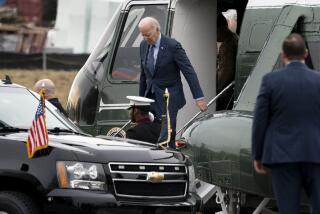Cheney Doctors Use Common Procedure
- Share via
WASHINGTON — Balloon angioplasty, the procedure performed Monday on Vice President Dick Cheney, is a frequently used method of opening up a blocked artery to restore blood flow to the heart.
Typically, it begins with catheterization--in which a thin, flexible tube is inserted into a blood vessel in the groin and threaded up to the arteries leading to the heart. Physicians then inject a special dye into the arteries, through the catheter, to locate the site of the blockage.
A small, deflated balloon then is threaded through the catheter to the site, where it is inflated--expanding the opening.
In Cheney’s case, physicians focused on the area where a stent (a tiny, scaffolding-like device used to widen the artery) was implanted in November, because subsequent narrowing frequently occurs.
Physicians said they widened the opening in the stent Monday from 2.5 millimeters to nearly 3 millimeters.
The procedure took about an hour, and Cheney dozed through it, the doctors said.
“We knew in November there would be a 20% likelihood of this,” said Dr. Jonathan Reiner, the cardiologist who performed the procedure at George Washington University Medical Center. “So we watched him very carefully.”
Dr. Douglas Zipes, president-elect of the American College of Cardiology, said that such a blockage--known as in-stent stenosis, or a narrowing within the stent--often is the result of excess tissue growing in the area, similar to the formation of scar tissue after surgery.
“There is a kind of exuberant tissue response that often happens, over weeks or months, that becomes excessive. And that can produce a narrowing of the stent,” Zipes said. “They blow up the balloon and you just push the debris up against the stent and the artery wall to clear it. And that restores the opening of the vessel,” he said. “It’s a very accepted technique.”
Reiner likened it to “a garden hose that starts to fill with sediment. . . . The effect of channeling inside the hose has been dramatically narrowed.”
Zipes said that “sometimes they have to put a second stent in.”
Cheney has a 40% risk of re-narrowing of the artery, Reiner said.
The cardiologist said that Cheney’s initial set of blood tests indicated that there was no evidence he had suffered another heart attack. Reiner also said that he did not believe Cheney had suffered any additional heart damage. The presence of certain enzymes in the blood is an indication of heart muscle damage.
“The initial and only set of blood tests are normal,” Reiner said when asked if Cheney had suffered a fifth heart attack. “So as of now, there is no evidence of that.”
The physicians emphasized that Cheney has chronic heart disease, but they said there is no reason he cannot vigorously resume his vice presidential duties.
Dr. Hugh Trout, a Maryland vascular surgeon, said that a patient such as Cheney could “go for a long time having these attacks” and remain fine as long as “you can keep the blood supply to the heart muscle.”
(BEGIN TEXT OF INFOBOX / INFOGRAPHIC)
Cheney’s Cardiac Procedure
Vice President Dick Cheney, who has had four heart attacks, underwent an angioplasty Monday for a partially blocked artery. Here’s how such a procedure is done:
*
1. A balloon catheter with a wire mesh tube, called a stent, placed over it is inserted near the patient’s groin and guided through a blood vessel to the coronary artery.
*
2. Once at the narrowed section of artery, the balloon is inflated to open the artery.
*
3. The stent is inserted to keep the artery propped open. The balloon is deflated and the stent is left in place to keep the vessel open.
*
Sources: Staff and wire reports; Harvard Heart Letter; Associated Press; American Heart Assn., Cordis Corp.; Researched by JULIE SHEER /Los Angeles Times






